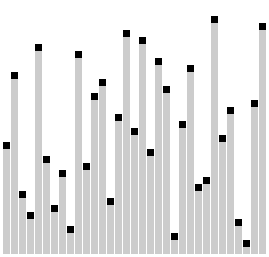Data structure Array | ||
 | ||
Worst-case performance O ( n 2 ) {displaystyle O(n^{2})} Best-case performance Θ ( n log n ) {displaystyle Theta (nlog n)} Average performance Ω ( n 2 / 2 p ) {displaystyle Omega (n^{2}/2^{p})} , where p is the number of increments Worst-case space complexity O ( 1 ) {displaystyle O(1)} | ||
Comb sort is a relatively simple sorting algorithm originally designed by Włodzimierz Dobosiewicz in 1980. Later it was rediscovered by Stephen Lacey and Richard Box in 1991. Comb sort improves on bubble sort.
Contents
Algorithm
The basic idea is to eliminate turtles, or small values near the end of the list, since in a bubble sort these slow the sorting down tremendously. Rabbits, large values around the beginning of the list, do not pose a problem in bubble sort.
In bubble sort, when any two elements are compared, they always have a gap (distance from each other) of 1. The basic idea of comb sort is that the gap can be much more than 1. The inner loop of bubble sort, which does the actual swap, is modified such that gap between swapped elements goes down (for each iteration of outer loop) in steps of a "shrink factor" k: [ n/k, n/k2, n/k3, ..., 1 ].
The gap starts out as the length of the list n being sorted divided by the shrink factor k (generally 1.3; see below) and one pass of the aforementioned modified bubble sort is applied with that gap. Then the gap is divided by the shrink factor again, the list is sorted with this new gap, and the process repeats until the gap is 1. At this point, comb sort continues using a gap of 1 until the list is fully sorted. The final stage of the sort is thus equivalent to a bubble sort, but by this time most turtles have been dealt with, so a bubble sort will be efficient.
The shrink factor has a great effect on the efficiency of comb sort. k = 1.3 has been suggested as an ideal shrink factor by the authors of the original article after empirical testing on over 200,000 random lists. A value too small slows the algorithm down by making unnecessarily many comparisons, whereas a value too large fails to effectively deal with turtles.
The pattern of repeated sorting passes with decreasing gaps is similar to Shellsort, but in Shellsort the array is sorted completely each pass before going on to the next-smallest gap. Comb sort's passes do not completely sort the elements. This is the reason that Shellsort gap sequences have a larger optimal shrink factor of about 2.2.
Pseudocode
function combsort(array input) gap := input.size // Initialize gap size shrink := 1.3 // Set the gap shrink factor sorted := false loop while sorted = false // Update the gap value for a next comb gap := floor(gap / shrink) if gap > 1 sorted := false // We are never sorted as long as gap > 1 else gap := 1 sorted := true // If there are no swaps this pass, we are done end if // A single "comb" over the input list i := 0 loop while i + gap < input.size // See Shell sort for a similar idea if input[i] > input[i+gap] swap(input[i], input[i+gap]) sorted := false // If this assignment never happens within the loop, // then there have been no swaps and the list is sorted. end if i := i + 1 end loopend loop end function
